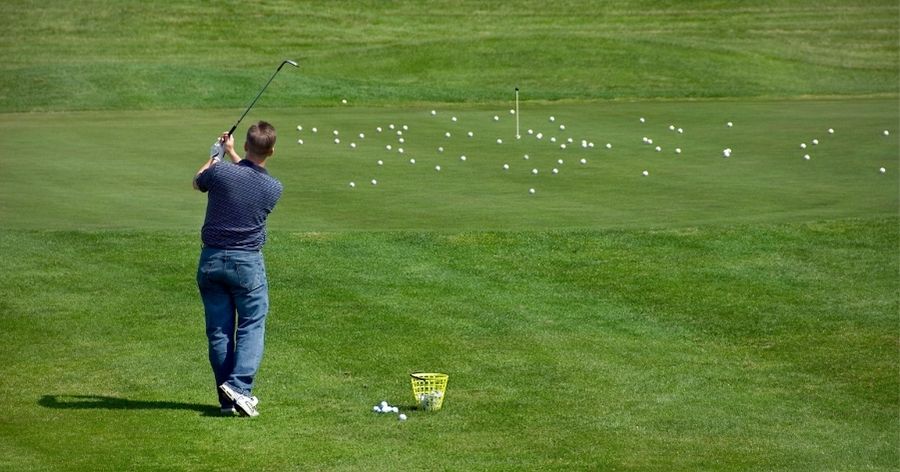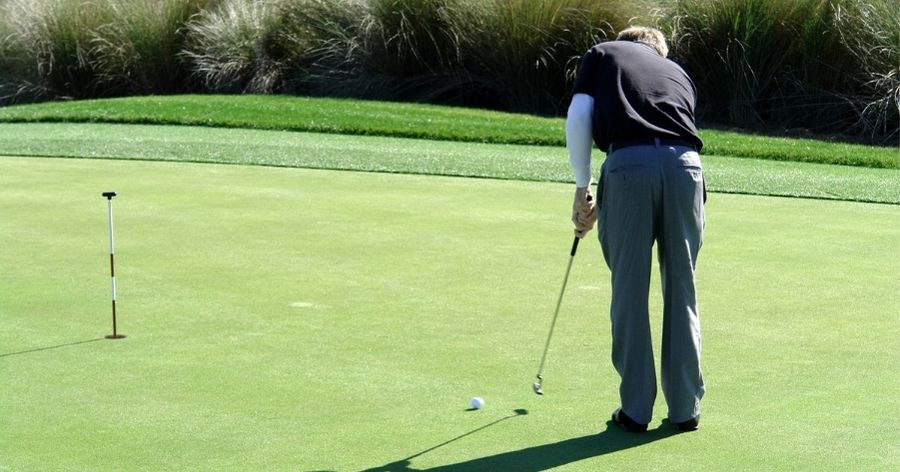
I honestly thought breaking 100 was it for me.
I enjoyed the game, I didn’t take it too seriously, and shooting between 90 and 100 only after three months of playing felt amazing.
But shortly after celebrating my first round under 100 (96 to be exact), I set my sights on a new target – shooting in the 80’s!
FUN FACT:
Roughly 25% of golfers ever achieve this feat, making it a coveted achievement in the golf community.
I quickly learned that shooting below 90 wasn’t just luck or a test of skill – it needed more finesse, less ego, and more strategy.
In fact, the skills and tips I developed to break 100 weren’t enough to break 90.
I had to improve all aspects of my game.
I needed to incorporate new drills, new strategies, and a new mindset to overcome this monumental feat.
And it paid off! Within 4 months of breaking 100, I finally shot an 88.
That’s why I created this article.
So if you want to learn how to break 90 consistently, such as:
Then this post on how to break 90 in golf is for you!
Let’s jump in.
Understanding What It Takes to Break 90 in Golf
Shooting in the 80s separates the weekend warriors from those who’ve started to figure out this maddening, but beautiful game.
This level of golf is when you start developing a deeper understanding of the game.
Since you can already make solid contact with the ball and hit it fairly straight on most shots, you can now start diving into course strategy and tweaking your short game.
What Is The Significance Of Breaking 90 In Golf?

The significance of shooting under 90 stems from the fact that the majority of recreational golfers spend their entire golfing lives trying to break past this barrier.
As I mentioned earlier, only 25% of golfers can do this.
And for those counting, a score below 90 means you’re consistently hitting bogey golf or better.
You can bogey all the holes and still shoot 90, but you need at least 1 par to shoot 89 – which looks better on the scorecard.
This indicates that you’re now a mid-handicap golfer (handicap range of 15-19) instead of a high handicapper (20+hcp).
Shooting in the 80’s is a clear indicator you’ve moved beyond the basics, ready to tackle more nuanced aspects of the game.
You’re not just hacking away at the ball anymore; it’s about playing the game with purpose.
Is Breaking 90 In Golf Good?
Let’s cut to the chase: Yes, hitting this milestone isn’t just good, it’s fantastic.
For many golfers, shooting under 90 is like joining a new league because you’re not just participating anymore, you’re competing.
You’re the player making others nervous on the first tee.
It’s a sign that your game has matured, your mistakes have become fewer, and your recovery shots are dialed in.
12 Actionable Tips on How To Break 90 In Golf
1. Start from the Front Tee Boxes

One strategy that might seem counterintuitive, yet has shown to be immensely effective, is starting from the front tee boxes – hear me out.
Before you start thinking it’s a hit on your ego, consider this: playing from the front tees isn’t about making the game too easy.
It’s about making smart choices that enhance your chances of shooting low at the end of the round.
A study from the “Journal of Sport Behavior” in 2016 illuminated how tee color affects amateur golfers’ psychological states.
Players reported feeling more confident and less anxious when they chose tees aligning with their skill level.
This psychological boost can translate into better performance and is a pivotal part of improving your golf game.
When confidence is up, shots tend to be more accurate, and decision-making is sharper.
I only recommend this tip, if you’re trying to break 90 for the first time.
If you’re consistently shooting in the 80’s, then you should be playing further back.
When I made this adjustment in my game, I noticed something different.
My shots per round were going down. My Greens in Regulation (GIR) percentage went up.
I saw more opportunities to use clubs I was more comfortable and accurate with.
I saw more pars and bogeys instead of doubles and triples.
The front tees gave me a fresh perspective on managing the course, encouraging me to think two shots ahead and play the percentages.
Honestly, too much ambition on a golf course often leads to those soul-crushing doubles or worse.
I know everyone wants to launch the ball off the tips like we’re in the final round of the Masters, but if shooting in the 80s is your mission, it’s time to swallow that golfer’s pride and tee it up from the front.
2. Recognize Where You’re Losing Strokes
Another good tip on overcoming this challenge doesn’t involve swinging a golf club harder or investing in fancier gear…
Instead, it’s about finding out where you’re losing those shots.
“Well how do you do that?” you may ask.
By keeping a detailed log of your rounds. Yes, all of them.
This isn’t just about counting bogey, double bogeys, or even worse, double pars.
It’s about documenting your stats:
- What golf club did you use for each shot and where it landed?
- Do you hit fairways off the tee? If you didn’t, where did you miss – left, right, miss short?
- How many chip shots did you take?
- How many penalties?
- How many putts?
- How many GIRs did you get?
The list can go on, but I suggest you start tracking your data to understand what you need to work on the next time you’re at the range.
If you missed the fairway, work on your swing.
If you’re constantly short on each shot, adjust your club distances.
If you’re constantly three-putting, work on your putting stroke.
Understanding where you’re losing shots is the first step in mitigating them.
I personally use an app called 18 Birdies.
It allows you to log a ridiculous amount of data for the sole purpose of reviewing where you can improve.
3. Eliminate Penalty Strokes

Penalties often sneak up when your golfing capabilities don’t align with what you saw on TV.
You know those “hero” shots. I’m sure you’ve had internal dialogue that goes with it.
The “long carries over water” shots – “I can carry this with my 4 iron”.
The “drivable par 4” shots – “I can drive this and make an eagle”.
The “fairway bunker” shots – “I can still make the green from here”.
Remove this thinking from your head and stick to boring golf.
First off, understand the course like the back of your hand.
As part of your pre-game, or even pre-shot routine, do a quick recon of the course.
Know where the hazards are and try to avoid them – water, bunkers, deep grass, and even trees.
I hate having to waste a shot because I’m behind a tree!
Adjust your shot and plan accordingly to remove those hazards from play.
If you want to break 90 fast, then I suggest sticking to a home course until you do.
If you pair this tip with my 2nd tip (documenting your shots), then you’ll have a good understanding of what shots to take to avoid the hazards.
Secondly, choose the right club for each shot.
If you’re not sure you can clear a hazard with your long iron, hybrid, or 3 wood, then club down – don’t let your ego make the decision.
Clubbing down ensures you’re more accurate, even if you’re sacrificing distance. Your ball should be in play rather than out-of-bounds (OB).
Lastly, lay up. Simple as that.
Don’t drive those short par 4’s.
Don’t try to hit over trees if it’s a dogleg left/right.
Yes, it might bruise your ego, but it’ll feel a lot better than dropping an extra shot because your ball went OB.
4. Use Forgiving Clubs

I hate to say this but getting forgiving clubs was one of the best investments I made in improving my game.
Before you roll your eyes and think I’m simply stating the obvious, hear me out.
When I first started, I was the type to hold off on buying new clubs because I figured my second-hand set (that’s 20 years old) was more than enough.
It wasn’t until I went on vacation and needed to rent a set (which were Titleist T300’s).
Before the vacation, I hovered around 95-102, but on that day, I shot a 91 and I was convinced it was because of the T300s.
Although I didn’t shoot under 90, it swayed me just enough to think that I needed an upgrade to play better golf.
Don’t go out and pick the most expensive or the brand your favorite golfer uses, instead focus your efforts on buying “forgiving” or “game improvement” clubs.
Forgiving clubs are designed with one goal in mind: to make your bad shots not so bad.
These clubs are built with larger sweet spots, making it easier to hit the ball squarely even when your swing isn’t picture-perfect.
Plus, the perimeter weighting on these clubs is designed to reduce sidespin, which means those dreaded slice shots could become a thing of the past.
Lastly, consider opting for hybrids instead of long irons such as a 3 iron (3i) or 4 iron (4i) as they’re much easier to hit due to the clubhead design.
5. Practice Short Game – Pitching, Chipping and Putting

Whatever your goal might be, pitching, chipping, and putting will always be a constant area you’ll need to work on if you want to play golf well.
They’re the shots that should be your most accurate shots and should bring you within 10 feet of the pin.
A well-placed pitch or chip should give you a 1-putt opportunity, or at most a 2-putt.
Chipping
This is your go-to short-game shot for anything just outside the green.
The main thing to understand is that the more loft you have in your club, the less roll.
Coincidentally, the less loft you have in your club, the more roll you’ll have.
Factor that principle in your head when you’re dealing with short-side or long-side pins.
Lastly, practice!
Practice on the chipping green before your tee time.
Practice using a golf towel under your arms to ensure your elbows are tucked in.
Practice with different clubs to see how the ball behaves and see how much roll a sand wedge has compared to a 9i.
Pitching
Your pitch shot should be one of your most confident shots – not a flop shot!
It’s the one you use if you’re 30 to 50 yards out, or if you need to clear a bunker, or if you want to hit the green and land the ball softly.
In these situations, you need to trust your skills in making clean contact and learning to control the right amount of power to accomplish this shot.
Skull the ball, and it’ll go flying past the green.
Not enough power, then you’re not clearing the bunker.
With just the right power and spin, you could be looking to putt for a birdie.
Putting Within 6-feet

Before I lay out the perfect step-by-step guide, let’s embrace some stats about putting, especially within 6 feet.
First off, why 6-feet?
Well unless you’re gifted enough to chip or dial in your approach shot to 6 feet, chances are then it’s because you lag putted yourself to within 6 feet.
Did you know that golfers making a 3-foot putt manage to sink the ball 84% of the time?
Once that distance increases to 6 feet, the success rate plummets to 45%.
These numbers highlight the importance of the short game.
Now, here are 6 actionable steps on how to elevate your putting, and help you break 90 on the golf course:
- Craft Your Shot Routine
- Consistency breeds success.
- Before every putt, visualize the path, take a couple of practice swings, and then execute.
- A consistent routine before each putt eases anxiety, fostering a sense of familiarity, even in high-pressure situations
- Personally, my routine is as follows:
- Mark ball > Determine line > Place ball down and align it to my chosen line > Practice swing to determine strength > Set up and align feet > Execute
- Perfect Your Alignment
- Misalignment is often the culprit behind missed short putts. Use alignment tools or simply place a club on the ground parallel to your putt line during practice to ensure your stance and putter face are perfectly aligned with your target.
- Personally, I use line markers on my ball as well as the line marker behind my putter, to align my shots
- Improve Your Green Reading Ability
- Even within 6 feet, slopes on the green can turn a straight shot into a missed opportunity. Spend time understanding how the ball behaves on different slopes and under various conditions. This insight will significantly increase your chances of sinking those short putts
- Focus on the Fundamentals
- Grip, stance, and posture are the “basics of putting” and form the foundation of successful putts. Regular checks ensure bad habits don’t creep in
- Develop Soft Hands
- A tense grip can wreak havoc on short putts. Aim for a grip that is firm yet gentle enough to allow for a smooth, pendulum-like stroke. Practicing with a looser grip helps in developing the touch and feel necessary for those delicate short putts
- Personally, my grips feel like I’m gripping the club with just my fingertips
- Drill, Drill, Drill
- Practice makes permanent. Setting up mock scenarios that mimic real-game pressure can do wonders.
- Some sample drills to challenge yourself:
- Sink 10 consecutive putts from within 5 feet before ending your practice session
- Sink 6 golf balls around a hole at a distance of 3 feet (slightly longer than your club length and slightly longer than “gimmes”)
6. Practice 5 distances (50, 75, 100, 125, 150)

In my journey to shoot sub 90, mastering five specific distances—50, 75, 100, 125, and 150 yards—emerged as a game-changer.
Why these numbers?
Honestly, these were the numbers that were visible at my driving range 😜.
I was able to zap it with my rangefinder and gauge how close my shot was.
Additionally, these are the most common ranges you’ll find yourself in.
50 Yards
Starting with the 50-yard distance, this shot often arises just shy of the green.
Practice using a wedge (I use a SW for these shots), focusing on a smooth, controlled swing, and ensuring the ball lands softly, minimizing roll.
50 yards is a precision shot and should be a distance where you can aim and get close to the pin, preferably within 6 to 10 feet.
75 Yards
Moving up to 75 yards, the strategy shifts slightly.
Here, it’s critical to strike a balance between power and precision.
I can still use my SW for this shot but it would have to be a full swing, which I’m not comfortable with. Instead, I’ll use a GW with a 50-75% swing.
Similar to the 50-yard approach, it’s about precision and landing it softly on the green.
100 Yards
At the 100-yard mark, you’re entering a zone that can significantly cut down your scorecard or blow up the hole – why?
Because you’re far enough to need a bit more power but close enough that finesse remains crucial.
Using a full swing this close to the pin can send your ball flying if you don’t make solid contact – that’s why 100 yards is all about distance consistency.
125 Yards
Depending on your club distances, the 125-yard distance will test your PW-8 iron game.
Don’t expect to be 3 feet to the pin at this distance, instead, this is the distance to strategically set yourself up for an easy putt.
For example, if you notice the pin on the edge of the green, aim for the center of the green to eliminate a short side wedge shot. Even if you mishit left or right, you’ll still have a chance to be on the green.
150 Yards
Finally, the 150-yard shot.
For recreational golfers, this would be an 8-5 iron shot – personally for me, it’s my 8 iron (8i) or 7 iron (7i).
If I want the ball to run up to 150 yards, I’ll use the 8i. But if I want to carry 150 then it’s my 7i and depending on the situation, I’ll choose one over the other.
This distance can be commonly found in your second shot at par 4’s.
Being the second shot, it’s important to hit any part of the green so you can set yourself up for a 2-putt and eventually save par.
What we don’t want is to take three shots from this distance.
We need to hit the green or somewhere close for an easy up and down.
7. Meditation and Visualization
While everyone else is obsessing over the latest driver that promises to blast the ball to the moon, I zero in on the real deal – the mental game, more importantly, meditation and visualization.
Don’t mistake the two. Both mind techniques are for different purposes and one is not better than the other.
Meditation
First off, meditation.
It’s not just for yogis or those looking to find their inner peace (although, hey, that’s a bonus).
It’s about gaining control over your thoughts and emotions on the course.
Stress and anxiety are like bogeys; they add up and sabotage your score.
Think about it, when was the last time you hit a bad shot, then hit another bad one, and soon realized your game had completely spiraled out of control?
By incorporating just 10 minutes of meditation into your daily routine, you can significantly reduce these bad thoughts and feelings, allowing for more focused and confident shots.
Visualization
Visualization, on the other hand, isn’t about controlling your emotions (like meditation), it’s more about “seeing” your desired outcome before it happens.
This isn’t just fancy daydreaming; it’s backed by science.
Visualization stimulates the same neural pathways in your brain as physically performing the action does.
So, when you visualize that perfect shot, you’re priming your brain and body to make it happen in reality.
Try it next time! Before each shot, take a moment to close your eyes and paint a mental picture of your ball soaring beautifully and landing exactly where you want it.
Visualization practice not only boosts confidence but also prepares your brain and body to execute the shot as envisioned.
8. Practice Course management

Course management is just another term for risk management, and it’s one of the best tips to break 90.
It’s not just about knowing where the hazards and sand traps are, it’s all about making smart, strategic moves and thinking several shots ahead.
Understand Your Strengths and Weaknesses
We all have glaring weaknesses in our golf game, but it’s important to be aware of them so you can avoid them.
Don’t like the bunker? Well, don’t use the course to start “practicing” your bunker shots.
Instead, play to your strengths.
For example, if the pin is 200 yards away but you’re not comfortable hitting your long iron or hybrid, opt for a club you’re familiar with.
Even if it’s a 7i that goes for 150 yards, it’s better to be accurate and in-play instead of OB.
Select the Right Club Off the Tee
It’s fun taking out my driver and blasting the golf ball 250+ yards off the tee, but you know what’s not fun?
Seeing that same golf ball being sliced into the woods never to be seen again.
Choosing the right club in your bag on Par 4s and 5’s isn’t about showcasing your mighty driver, it’s about playing smart, and playing smart might mean clubbing down.
If your driver isn’t cooperating with you, choose a fairway wood (3 wood or 5 wood are good alternatives), or even a hybrid.
If a hole screams danger with its layout, opt for a club that ensures that you’ll hit the fairway.
Embrace the Layup
As a byproduct of clubbing down as mentioned in the tip above “Select the Right Club Off the Tee”, you will ultimately end up having to “lay up” on most of your shots.
That’s perfectly fine.
That’s the smart play instead of trying to “go for the green” with a hero shot.
Hero shots more often than not end up somewhere unplayable, so embrace the layup.
Don’t Aim at the Flag
I know this sounds counter-intuitive but aiming for the flag on every approach shot can lead you to missing the green entirely, and opting out for a chip shot.
First off, greens are tricky.
They’re designed with subtle slopes and contours and are often guarded by bunkers, water, or the dreaded rough.
On top of all those traps, the greenkeeper will strategically place the pin near the edges of the green causing a short side and long side option.
Aiming at the flag can sometimes lead you straight into these traps or force you to play on the short side.
Instead, pick a spot somewhere near the middle of the green. Regardless if it’s a front pin, back pin, or left or right pin, always aim for the center.
Even if you mishit, this method will increase your chances of landing on the green and reduce your chances of landing in a trap or a difficult situation.
9. Practice Recovery Shots

One of the most underrated tips available and one that can instantly get you a better score.
While everyone is trying to perfect their grip, stance, takeaway, downswing, etc. they forget that a good portion of their shots will be coming from the rough, bunkers, uneven hills, or even around trees and bushes.
Instead of just whacking the ball hoping it’ll land on the fairway, a strategic recovery shot like a punch out or bump-and-run can help keep those double bogeys off your scorecard.
Punch Out
For punch outs, it’s all about keeping the ball flight low, similar to a stinger.
Depending on the obstacles around you and the type of height you want, I’d recommend using anything from a 7i up to a 4H.
To setup, choke down on the grip and play the ball back in your stance, ultimately delofting the club even further.
This helps keep the ball under tree branches and mitigates the wind’s effect on the ball.
Bump and Runs
A bump and run shot is your best friend when you need the ball to land softly and roll out toward the hole.
Opt for a less lofted iron, like a 4i or 7i, and use a putting setup/motion to pop the ball onto the green and let it run out.
Both the punch out and bump and run require meticulous practice.
You need to go through each club, from 4i/4h to 8i, and learn the different types of trajectory (high vs low flights), direction, and distance of each shot (carry and total).
10. Play With Better Players
Playing with better players is a great way to learn how to be a better player.
This is straightforward, but not in the ways you might think.
See when I first played with people significantly better at golf than me, I expected that they were better than me in every aspect of the game.
Don’t get me wrong, they were better than me, but not in the areas I imagined.
I thought they’d have “Tour Level” golf swings – this wasn’t the case.
Their swings were normal or even unorthodox.
I thought they’d bomb the golf ball 300+ yards – nope, not this either.
Their distances were the same as mine.
So what gives?
Well, I found that the discrepancy lies within their habits, strategies, and attitudes towards the game.
They take their time with each shot.
Not because they’re trying to slow the game down, but because they understand the value of preparation and want to go through their foundational checkpoints before they hit their next shot – grip, stance, alignment, etc.
They’re disciplined with their shot selection.
For example on their tee shot, if they notice that there’s a hazard 250 yards out, they won’t try to bomb it with their driver and hope they miss the hazard.
Instead, they’ll drop down to a 3 wood to shoot 230 and remove the hazard altogether.
I’ve found that incorporating all these little details helped me break 90 in golf consistently.
11. Use A Reliable Driving Club
I’ve seen plenty of golfers, including myself, get lured into the trap of thinking a powerful drive equals a successful hole.
Don’t get suckered into this mindset and ditch the ego-pumping, crowd-pleasing monster drives that end up two fairways to the right.
One of the secrets to shooting under 90 is making sure every shot counts, and it all starts with your drive.
If you’re constantly searching for your ball throughout the round, you’re not just losing balls; you’re losing strokes and momentum.
Instead, grab that trusty club that consistently lands your ball on the fairway.
Whether it’s a 3-wood, hybrid, or even a long iron, the goal is to swing and get the ball in play.
Frequently Asked Questions
What percentage of golfers can break 90?
Many sites and stats say that only around 25% of golfers regularly break 90.
From personal experience, this percentage is fairly accurate.
Out of 20-30 of us, containing a mixed group of close friends and acquaintances, about 4 of us can regularly shoot in the 80’s.
How long should it take to break 90 in golf?
This depends on a lot of things.
Natural athleticism (meaning hand-eye coordination), deliberate practice time, rounds played, coaches, intent, etc.
There are a lot of factors to consider.
I was able to achieve this goal within 7-8 months.
Sometimes it takes golfers 3-5 months.
Then there are others who’ve been playing for years and still haven’t broken 100.
It all depends.
Do I need lessons to break 90?
Yes. I’d suggest that most golfers need lessons to take their game to the next level.
If you’re struggling to break 90, then coaches and lessons can definitely help.
They can correct foundational issues in your stance, swing, grip, etc. that are causing most of your problems to begin with.
Removing bad advice can prevent them from being bad habits.
With that being said, I didn’t take lessons.
I watched a lot of YouTube videos and did a lot of trial and error.
Tried a lot of tips and tricks. I kept the things that worked and made sense, but I also took out a lot of things that didn’t sense.
Although I was able to do it within 8 months of starting, I don’t recommend it for most golfers.
Final Thoughts on How To Break 90 in Golf
Shooting in the 80s is no slouch!
It requires much more finesse and strategy than just making contact with the ball.
You need to be able to select the right club at the right time.
You need to be able to plan your shots accordingly.
You need to be able to get out of tough situations without sacrificing too many strokes.
Hopefully the 11 tips I’ve outlined above have shown you how to break 90 in golf.
Cheers!
Before You Go…
If you’re serious about lowering your score and taking your game to the next level, you need to be able to start capitalizing on par 5’s by making some birdies.
I’ve created three posts to help with that:
- Mastering your second shot with a fairway wood
- Short game secrets with two of the most popular wedges
Or, if you really think you need guidance, consider getting golf lessons:
